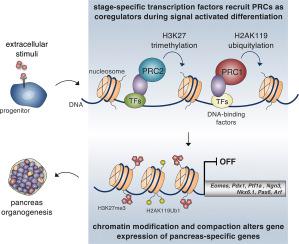当前位置:
X-MOL 学术
›
Mech. Develop.
›
论文详情
Our official English website, www.x-mol.net, welcomes your feedback! (Note: you will need to create a separate account there.)
Pancreas development and the Polycomb group protein complexes
Mechanisms of Development ( IF 2.6 ) Pub Date : 2020-12-01 , DOI: 10.1016/j.mod.2020.103647 Niloufer P Dumasia 1 , Prasad S Pethe 2
Mechanisms of Development ( IF 2.6 ) Pub Date : 2020-12-01 , DOI: 10.1016/j.mod.2020.103647 Niloufer P Dumasia 1 , Prasad S Pethe 2
Affiliation

|
The dual nature of pancreatic tissue permits both endocrine and exocrine functions. Enzymatic secretions by the exocrine pancreas help digestive processes while the pancreatic hormones regulate glucose homeostasis and energy metabolism. Pancreas organogenesis is defined by a conserved array of signaling pathways that act on common gut progenitors to bring about the generation of diverse cell types. Multiple cellular processes characterize development of the mature organ. These processes are mediated by signaling pathways that regulate lineage-specific transcription factors and chromatin modifications guiding long-term gene expression programs. The chromatin landscape is altered chiefly by DNA or histone modifications, chromatin remodelers, and non-coding RNAs. Amongst histone modifiers, several studies have identified Polycomb group (PcG) proteins as crucial determinants mediating transcriptional repression of genes involved in developmental processes. Although PcG-mediated chromatin modifications define cellular transitions and influence cell identity of multipotent progenitors, much remains to be understood regarding coordination between extracellular signals and their impact on Polycomb functions during the pancreas lineage progression. In this review, we discuss interactions between sequence-specific DNA binding proteins and chromatin regulators underlying pancreas development and insulin producing β-cells, with particular focus on Polycomb group proteins. Understanding such basic molecular mechanisms would improve current strategies for stem cell-based differentiation while also help elucidate the pathogenesis of several pancreas-related maladies, including diabetes and pancreatic cancer.
中文翻译:

胰腺发育和 Polycomb 组蛋白复合物
胰腺组织的双重性质允许内分泌和外分泌功能。外分泌胰腺的酶分泌物有助于消化过程,而胰腺激素则调节葡萄糖稳态和能量代谢。胰腺器官发生由一系列保守的信号通路定义,这些通路作用于共同的肠道祖细胞,产生不同的细胞类型。多个细胞过程表征成熟器官的发育。这些过程由调节谱系特异性转录因子和指导长期基因表达程序的染色质修饰的信号通路介导。染色质景观主要通过 DNA 或组蛋白修饰、染色质重塑和非编码 RNA 来改变。在组蛋白修饰剂中,几项研究已经确定多梳群 (PcG) 蛋白是介导发育过程中基因转录抑制的关键决定因素。尽管 PcG 介导的染色质修饰定义了细胞转换并影响多能祖细胞的细胞身份,但关于细胞外信号之间的协调及其在胰腺谱系进展过程中对 Polycomb 功能的影响仍有很多需要了解。在这篇综述中,我们讨论了序列特异性 DNA 结合蛋白与胰腺发育和产生胰岛素的 β 细胞相关的染色质调节因子之间的相互作用,特别关注 Polycomb 组蛋白。
更新日期:2020-12-01
中文翻译:

胰腺发育和 Polycomb 组蛋白复合物
胰腺组织的双重性质允许内分泌和外分泌功能。外分泌胰腺的酶分泌物有助于消化过程,而胰腺激素则调节葡萄糖稳态和能量代谢。胰腺器官发生由一系列保守的信号通路定义,这些通路作用于共同的肠道祖细胞,产生不同的细胞类型。多个细胞过程表征成熟器官的发育。这些过程由调节谱系特异性转录因子和指导长期基因表达程序的染色质修饰的信号通路介导。染色质景观主要通过 DNA 或组蛋白修饰、染色质重塑和非编码 RNA 来改变。在组蛋白修饰剂中,几项研究已经确定多梳群 (PcG) 蛋白是介导发育过程中基因转录抑制的关键决定因素。尽管 PcG 介导的染色质修饰定义了细胞转换并影响多能祖细胞的细胞身份,但关于细胞外信号之间的协调及其在胰腺谱系进展过程中对 Polycomb 功能的影响仍有很多需要了解。在这篇综述中,我们讨论了序列特异性 DNA 结合蛋白与胰腺发育和产生胰岛素的 β 细胞相关的染色质调节因子之间的相互作用,特别关注 Polycomb 组蛋白。


























 京公网安备 11010802027423号
京公网安备 11010802027423号